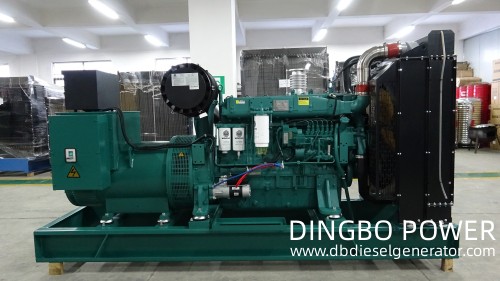dingbo@dieselgeneratortech.com
+86 134 8102 4441

- Home
- Products
- About Us
- Service
- News
- Technical Support
- Contact Us
dingbo@dieselgeneratortech.com
+86 134 8102 4441
Mar. 24, 2023
The cooling principle of diesel generator sets is to circulate the coolant through the engine, cooling devices usually have three types, one is a one-piece radiator cooling system, the second is a split cooling system, the other is a heat exchanger cooling system (also commonly known as water-cooled system in some areas), most generator sets use the radiator cooling system, because the fan driven by the engine will blow the air into the radiator, to achieve the purpose of cooling. The majority of diesel generator sets use radiator cooling system, because the fan driven by the engine will blow the air into the radiator, to achieve the purpose of cooling, or the radiator and engine split installation, by a powerful fan to cool; when the natural water supply is sufficient, the third cooling system can be used, that is, the heat exchanger to replace the radiator, the engine coolant through the heat exchanger to circulate, and by the natural water to cool.
1.Connected radiator cooling system
This cooling method is a standard cooling system for diesel generator sets. The radiator is installed together with the engine, and its fan is installed coaxially with the engine, powered by the engine crankshaft.
2.Split radiator cooling system
Commonly known as the remote water tank cooling system, due to the limitations of the computer room environment, most of the cooling radiators are required to be disassembled and separated from the genset due to poor ventilation in the computer room, and installed in an environment where the air is easy to circulate. At this time, the cooling fan needs to be driven by a thermostatically controlled motor, which can request power from the engine only when it is necessary to cool the engine.

Installation considerations:
(1)For remote installation of radiators, increasing the length of the delivery pipeline will increase the resistance of the cooling water flow, and relying solely on the engine's water pump may not ensure the circulation power of the coolant. If long-distance delivery pipelines are unavoidable, it is necessary to consider installing a circulation pump to compensate for the pressure drop in the pipeline system.
(2)If the radiator is installed at a height, its coolant pressure head should not be higher than the allowable range of the engine water pump, that is, it should not be higher than 17 meters; To avoid excessive pressure causing leakage of the water pump seal.
(3) The infusion pipe system of the cooling system should be straight as far as possible. If the pipe system is bent, it may seal trapped gas in the vertical curved section of the pipeline, resulting in a decrease in heat dissipation capacity. If large radius curved pipes are unavoidable, a vent pipe must be installed at the highest point of the curved section and connected to the expansion tank.
(4)In addition to the functions of defoaming and expansion, the expansion tank should also consider its capacity reserve, which is generally 15% of the total capacity.
3.Heat exchanger cooling system
When the natural water supply is sufficient, heat exchangers can be used, especially in areas with excessive impurities in the air, which can avoid causing the radiator to be injured or blocked by debris. In this system, the heat exchanger acts as an intermediary heat exchange device, separating the engine cooling system from the high static head of the split radiator. The engine pump circulates the coolant within the engine and heat diffuser, while another independent pump circulates the coolant between the split heat exchangers, commonly referred to as internal and external circulation. The external circulation heat can be cooled through a cooling tower.
1. Heat exchanger+remote radiator
When the remote radiator must be installed outside the machine room, it is recommended to add a heat exchanger, as there are two independent cycles responsible for heat dissipation, which is a protection for the cooling cycle of the unit. The heat exchanger shall be equipped with a make-up water tank, and the circulating water pump shall be installed at the lowest point of the system, taking into account the configuration of the backup water pump. The pipes connecting the radiator and heat exchanger must be made of rust-proof materials such as plated steel and aluminum, and soft connections should be used when connecting the diesel genset.
2. Heat exchanger+cooling water tower
When the temperature of the machine room is on the high side and the ventilation system is not smooth, the cooling water tower can be considered. The working principle of a cooling water tower is similar to that of a remote water tank, but the latter is a fully enclosed type of circulating water, and the water in the water tower will be cooled by outdoor air. Dust and acidic rain in the outdoor air can cause pollution to the circulating water in the water tower. Therefore, when using a water tower, attention should be paid to the treatment of the circulating water.
The cooling system is an important system necessary for the normal operation of diesel generator sets. Generally, standard cooling systems are selected. If you need to use in special environments or have special requirements for using other types of cooling systems, please consult the generator manufacturer first to provide you with the most satisfactory cooling system according to your needs. If you would like to learn more information, please contact us by email dingbo@dieselgeneratortech.com.
Quicklink
Mob.: +86 134 8102 4441
Tel.: +86 771 5805 269
Fax: +86 771 5805 259
E-mail: dingbo@dieselgeneratortech.com
WhatsApp: +86 134 8102 4441
Add.: No. 10 Kechuang Road, High tech Zone, Nanning, Guangxi, China